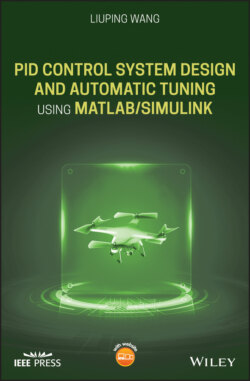Читать книгу PID Control System Design and Automatic Tuning using MATLAB/Simulink - Liuping Wang - Страница 42
Example 1.9
ОглавлениеIn this example, we will show how to use the tuning rules to find the PID controller parameters for the fired heater at the lower operating condition using the transfer function (1.58) and simulate the closed-loop response with a step reference signal using sampling interval (min) and a negative step disturbance entering at the half of the simulation time.
The higher operating condition case is left as an exercise.
Solution. Figure 1.21 shows the unit step response with the lines drawn to identify the time delay and time constant for a first order approximation. From the graph, the time delay is found as 9.54 min and the time constant min. With the steady-state gain equal to 3, the approximation using first order plus model leads to the following transfer function:
(1.60)
Now, applying the Ziegler–Nichols tuning rules (see Table 1.2), Cohen–Coon tuning rules (see Table 1.3) and Wang–Cluett tuning rules (see Table 1.6), we obtain the PI controller parameters for the fired heater process shown in Table 1.9. The PI controller parameters obtained are drastically different. The PI controllers using Ziegler–Nichols and Wang–Cluett tuning rules produce stable closed-loop system for the fired heater process, however the PI controller using Cohen–Coon tuning rules does not lead to a stable closed-loop system, which was verified using closed-loop simulation. To evaluate the closed-loop control performance, a unit step input signal is used as a reference and a step input disturbance with magnitude of is added to the closed-loop simulation at half of the simulation time. Figure 1.22(a) shows the control signals generated by the PI controllers and Figure 1.22(b) shows the output responses to the reference change and the disturbance signal. Both closed-loop systems have oscillations, but in comparison, the controller using Wang–Cluett tuning rules leads to a slightly better closed-loop performance with less oscillations.
Figure 1.21 Unit step response of the fired heater process.
Table 1.9 PI controller parameters with reaction curve.
| Ziegler–Nichols | 0.4239 | 28.6200 | ||
| Cohen–Coon | 0.4517 | 13.2353 | ||
| Wang–Cluett | 0.2835 | 15.7610 |
Figure 1.22 Comparison of closed-loop responses using Ziegler–Nichols and Wang–Cluett tuning rules (Example 1.9). (a) Control signal. (b) Output. Key: line (1) Ziegler–Nichols tuning rule; line (2) Wang–Cluett tuning rule.
